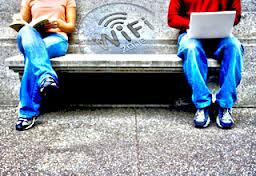Stay Safe On Public HotSpots
Public Wi-Fi hotspots are everywhere. Coffee shops, waiting rooms, highway rest stops, arenas, etc. If there’s people sitting around, chances are, there’s free WiFi.
And wherever there’s free WiFi, there’s security risks.
Connecting your device, whether it be a laptop, tablet, or smartphone, to a public WiFi hotspot is a little bit like stepping off the curb without looking; it’s dangerous. You could avoid connecting altogether, but that’s not an option when you’re on the road: You need to get work done, communicate, and access the Web, and public WiFi may be the only option available.
There are undoubtedly some doubters out there who are thinking right now “I’ve been on public WiFi lots of times, and nothing bad ever happened.” That may be true, but these days, blindly joining public WiFi hotspots is a little like playing Russian roulette. Every day that passes, the tools that CyberCriminals use to snoop, swipe, and infect your systems get better, easier to use, and more automated. If it only takes a few seconds for a data thief to break into your system and start wreaking havoc, then you need to spend a few minutes to make sure your defense shields are up. And it’s easy enough that even someone that doesn’t know the hard drive from the floppy drive (Hint: floppy drives don’t exist any more) can minimize their exposure to WiFi hotspot threats you’re likely to encounter.
- Maintain Security Software. This one should go without saying. However, we run into people several times a day, that either do not have or do not have up-to-date security software. Security software is typically pretty good at preventing unauthorized users from accessing your system, notifying you of the presence of infected files, and removing harmful link and malware. Make sure you have antivirus, anti-malware, and firewall utilities. Windows comes with firewall software enabled by default, but you may have to seek out third-party options for antivirus and anti-malware software. For instructions on how to make sure your firewall is enabled in Windows7 click: HERE. For instructions on how to make sure your firewall is enabled in Windows8 click: HERE. It’s also a good idea to make sure your device’s OS and other applications are up-to-date before you sign on to any public WiFi hotspot.
- Don’t Share. Never mind what Sesame Street taught you. The first time you connect to any network, Windows asks if you’re connecting to a Home Network, Work Network, or Public Network. Do yourself a favor and always select “Public Network” when connecting to a WiFi hotspot. This ensures that your device is not visible to others using the hotspot, blocks malicious software, prevents access to the HomeGroup, and turns off network discovery.
- Connect Manually. Although doing so may seem tedious, make sure you’re manually connecting to hotspots every time. Rogue hotspots hosted by CyberCriminals tend to use SSIDs (Service Set IDentifiers) that sound like they’re being hosted by a legitimate business. You may be inside a Starbucks, but that doesn’t mean you should trust any available hotspot with the coffee shop’s name in the SSID. Whenever possible, verify the hotspot’s SSID with an employee before signing on.
- Choose Password-Protected SSIDs. We know that the human instinct for immediate gratification is overwhelming. It’s easiest to try the open networks before inquiring about a password to one of the closed ones. But fight that urge. Although password-protected networks aren’t inherently any safer, they can help you determine whether the network is hosted by the business, or a nearby data thief with a portable router.
- Practice Safe Surfing. When you are connected to a public WiFi hotspot, avoid using e-commerce and banking sites, if possible. If you must connect to these sites, make sure that no one else has a clear view of your device’s screen or keyboard while you enter usernames or passwords. Also ensure that the sites on which you enter your information encrypt your data. Remember that secured URLs begin with “https”. When you are finished, log out of the site immediately.
Following these easy steps for keeping your device (and information) secure, will go a long way to thwarting would-be WiFi hotspot hijackers. Now you can connect with confidence.

Leave a Reply